
eBook - ePub
V14 Certification: Teradata Basics
Tom Coffing, John Nolan
This is a test
Share book
- 668 pages
- English
- ePUB (mobile friendly)
- Available on iOS & Android
eBook - ePub
V14 Certification: Teradata Basics
Tom Coffing, John Nolan
Book details
Book preview
Table of contents
Citations
About This Book
You are going to love this book because your confidence and knowledge will soar. V14 Certification: Teradata Basics has been designed to help you pass the test, but it is so much more. It is an incredible reference guide, learning tool, and foundation for passing all the tests and becoming a Teradata Certified Master.
Frequently asked questions
How do I cancel my subscription?
Can/how do I download books?
At the moment all of our mobile-responsive ePub books are available to download via the app. Most of our PDFs are also available to download and we're working on making the final remaining ones downloadable now. Learn more here.
What is the difference between the pricing plans?
Both plans give you full access to the library and all of Perlego’s features. The only differences are the price and subscription period: With the annual plan you’ll save around 30% compared to 12 months on the monthly plan.
What is Perlego?
We are an online textbook subscription service, where you can get access to an entire online library for less than the price of a single book per month. With over 1 million books across 1000+ topics, we’ve got you covered! Learn more here.
Do you support text-to-speech?
Look out for the read-aloud symbol on your next book to see if you can listen to it. The read-aloud tool reads text aloud for you, highlighting the text as it is being read. You can pause it, speed it up and slow it down. Learn more here.
Is V14 Certification: Teradata Basics an online PDF/ePUB?
Yes, you can access V14 Certification: Teradata Basics by Tom Coffing, John Nolan in PDF and/or ePUB format, as well as other popular books in Computer Science & Data Warehousing. We have over one million books available in our catalogue for you to explore.
Information
Chapter 1 – Teradata Basics and Data Warehouse Concepts
“I find that the harder I work the more luck I seem to have.”
– Thomas Jefferson
Passing Your Teradata Certification Tests
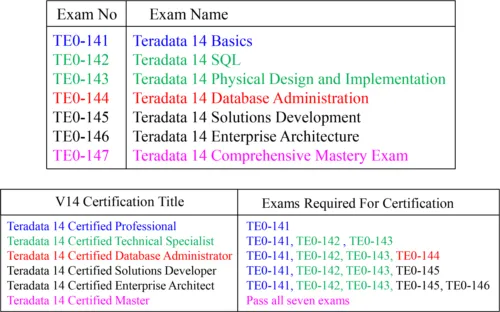
All exams must be taken and passed in the order listed. Teradata V12 Masters can take one test to achieve a V14 Masters Upgrade and that is TE0-147. Go to www.prometric.com/Teradata to register for an exam.
What is Parallel Processing?
“After enlightenment, the laundry”
- Zen Proverb

“After parallel processing the laundry, enlightenment!”
-Teradata Zen Proverb
Two guys were having fun on a Saturday night when one said, “I’ve got to go and do my laundry.” The other said, “What?!” The man explained that if he went to the laundry mat the next morning, he would be lucky to get one machine and be there all day. But, if he went on Saturday night, he could get all the machines. Then, he could do all his wash and dry in two hours. Now that’s parallel processing mixed in with a little dry humor!
The Basics of a Single Computer

Data on disk does absolutely nothing. When data is requested, the computer moves the data one block at a time from disk into memory. Once the data is in memory, it is processed by the CPU at lightning speed. All computers work this way. The "Achilles Heel" of every computer is the slow process of moving data from disk to memory. That is all you need to know to be a computer expert!
Teradata Parallel Processes Data
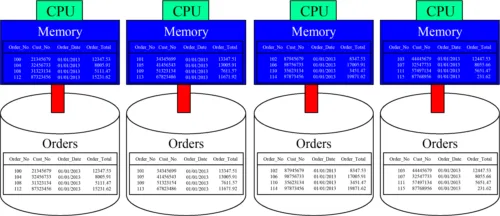
Teradata has been the pioneer in parallel processing since 1988 when Wells Fargo bought the first Teradata system. In the picture above, you see that we have 16 orders with four orders placed on each disk. It appears to be four separate computers, but this is one system. Teradata systems work just like a basic computer as they still need to move data from disk into memory, but Teradata divides and conquers.
Parallel Architecture
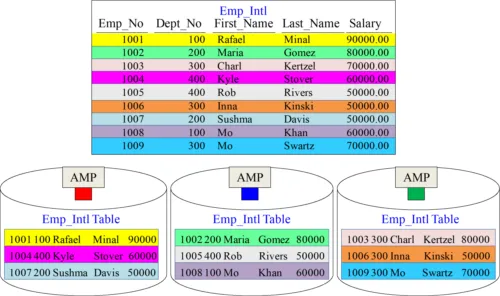
The rows of a Teradata table are spread across the AMPs, so each AMP can then process an equal amount of the rows when a USER queries the table.
The Teradata Architecture
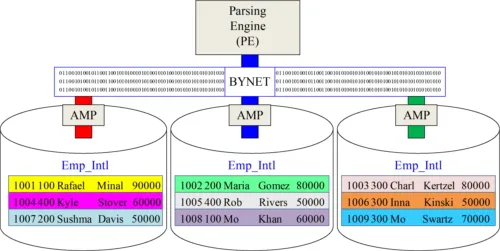
The Parsing Engine (PE) takes the User’s SQL and builds a Plan for each AMP to follow to retrieve the data. Parallel Processing is all about each AMP doing an equal amount of the work. If they start at the same time and end the same time, they are performing true Parallel Processing. All communication is done over the BYNET.
All Teradata Tables are spread across ALL AMPS

Each table dreams of spreading their rows equally across the AMPs. Above, are three tables with each table holding 9 rows (3-rows per AMP).
Teradata Systems can Add AMPs for Linear Scalability
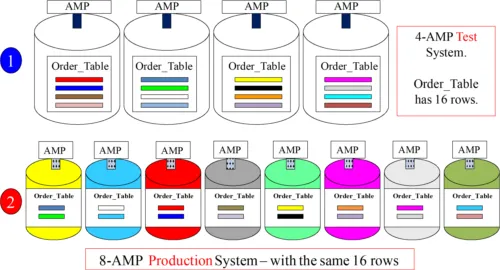
Linear Scalability means if you double your AMPs and their supporting nodes the performance doubles! System number one has only 4-AMPs, but system two has 8-AMPs and is twice as fast. When a customer buys more hardware, they are adding AMPs to the system. Once the hardware is configured, the AMPs will redistribute the data to include the new AMPs.
Understand that Teradata can scale to incredible size
“If you do what you've always done, you'll get what you've always got.”
- Anonymous
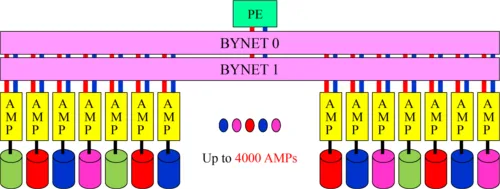
The largest systems in the world have used Teradata for market dominance for the past 20 years. Its Massively Parallel Processing (MPP) technology analyzes on such a large scale that companies can run queries they have never been able to run before. Recognize that you now have something very powerful and that has the ability to analyze every aspect of your business. So do what you’ve never done, and get something that you’ve never got.
AMPs and Parsing Engines (PEs) live inside SMP Nodes
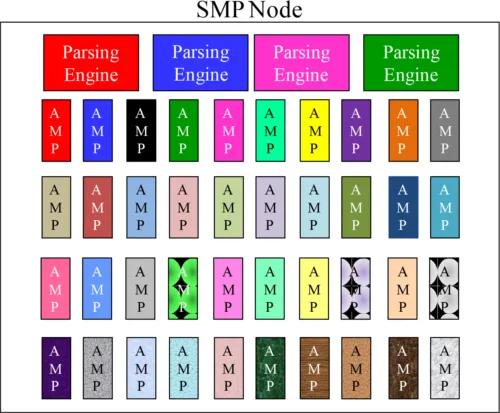
AMPs and PEs are called Virtual Processors because each is a process that lives inside a node’s memory. Think of a node as a very powerful personal computer. SMP stands for symmetric multi-processing which means each CPU processor performs equally, and all CPUs share a pool of memory and operate under one opera...